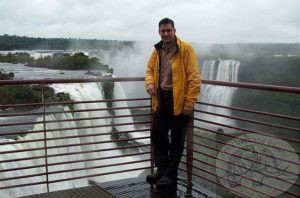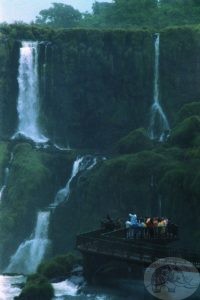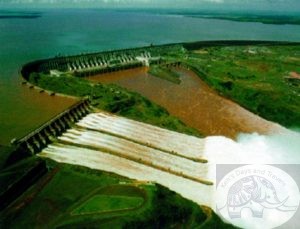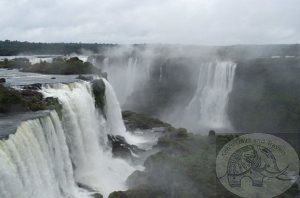
At Iguassu in the early 2000s
Beaches, Buzios, Brazil
I had been in Brazil twice before this particular trip, the first time in the early 1990s, the second about a decade later, and this third time another decade subsequent. Whereas on the first trip I had visited family in the southern area of the country and never made it to Rio, on the second trip I did have some time to spend in Rio as well as a city further north, Salvador, in the state of Bahia. The three different cities or regions all have a different vibe, with the southern region being more business/northern European in nature, with large swathes of land turned into prolific farms by immigrants from all over the world, including Dutch, German, Japanese, etc.

The bird park at Iguassu Falls, a worthwhile attraction
Rio is famous around the world for its beaches and the glamorous people who populate this seaside paradise (despite the fact that the city has one of the highest crime rates in the world). Bahia or Salvador, is much more relaxed, more musical, more colourful, and it certainly felt a lot safer than Rio (although that may have changed over the years). One thing I do remember from the second trip to Rio was a visit to a resort area not too far from Rio where the ‘well-to-do’ have their summer beach houses: Buzios. Located 160 km northeast of Rio, the resort town is considered one of the world’s most beautiful spots, and I would agree that the charming town offers the kind of facilities and holiday experiences that most sun seekers can only dream of. There is only one catch, however: I am not really a beach person, and for me, spending one day on or around Copacabana, or the beautiful beach at Buzios, or the Mediterranean or any other beach anywhere else in the world for that matter, is more than enough. There is only so much sitting in the sun, snorkeling and swimming I can handle; I much prefer mountains, jungles, forests, or non-coastal landscapes.

An observation platform at Iguassu
Iguassu, one of the world’s top 10 waterfalls
And so I shall tell you about Iguassu, one of the world’s greatest waterfalls. There is Niagara, the waterfall with the greatest volume of water passing through it, at roughly 1km in length. I have seen this waterfall numerous times, and it is impressive. Then there is Victoria Falls in Zimbabwe, at roughly 2km in length and a height of about 100 meters; it is a waterfall that I have not yet seen despite several trips to Africa, but it is definitely one of the places I want to visit. Then there are the Chutes de Khone in Laos, with a width of roughly 10km, making them the world’s widest falls, and I expect that I will get to see them before I get to see Victoria or Angel Falls. Angel Falls in Venezuela, the world’s highest waterfall dropping approximately 900 meters, was in my plan, but due to the political situation in Venezuela I had to give them a miss… and then there are the Cataratas del Iguazo which stretch approximately 3 kilometers along the border between Argentina and Brazil, and drop nearly 100 meters. Although not the largest waterfall in the world, Iguassu is spectacular to behold, and there are several platforms along the length of the falls where you can get up close and get wet. Like most other waterfalls in the world, there are boats that will bring you up close to the falls for that extra bit of a thrill. The day was a bit rainy when I visited, and it was in the off-season, so the tour groups were at a minimum, which was perfect. The walkways along the edge of the gorge allow for a nice hike, and as mentioned, there are platforms from which visitors can view any of the hundreds of the different falls that combine to make this one of the world’s most stunning natural wonders.

Itaipu hydroelectric dam
Hydro electric power plant – sustainable, green
Up river (actually, on the Parana river between Brazil and Paraguay), you can find another of the world’s modern wonders, the Itaipu hydro electric dam. This dam produced the most energy of any dam in the world in 2016, producing more energy even than the Three Gorges Dam in China. Up to 60% of Brazil’s energy needs are met by hydro power, of which the Itaipu Dam is one of the largest providers. On that trip, as with this most recent trip, the next stop was Rio de Janeiro, and more explorations in this mega city, including some great cuisine, visits to a botanic garden, the national library, and a museum that is focused not on the past, but on the future, the Museu do Amanha, or the Museum of Tomorrow, a must-visit for anyone traveling to Rio, even those who are terrified of the word ‘museum’ because this museum is unlike any other museum you may have experienced; it is not filled with old, decaying objects and artifacts thousands of years old, but instead tells the story of humanity, our effect on the world, and what the future holds in store for us if we do not start changing our rapacious actions – but that’s coming up in the next episode.

Iguassu falls
